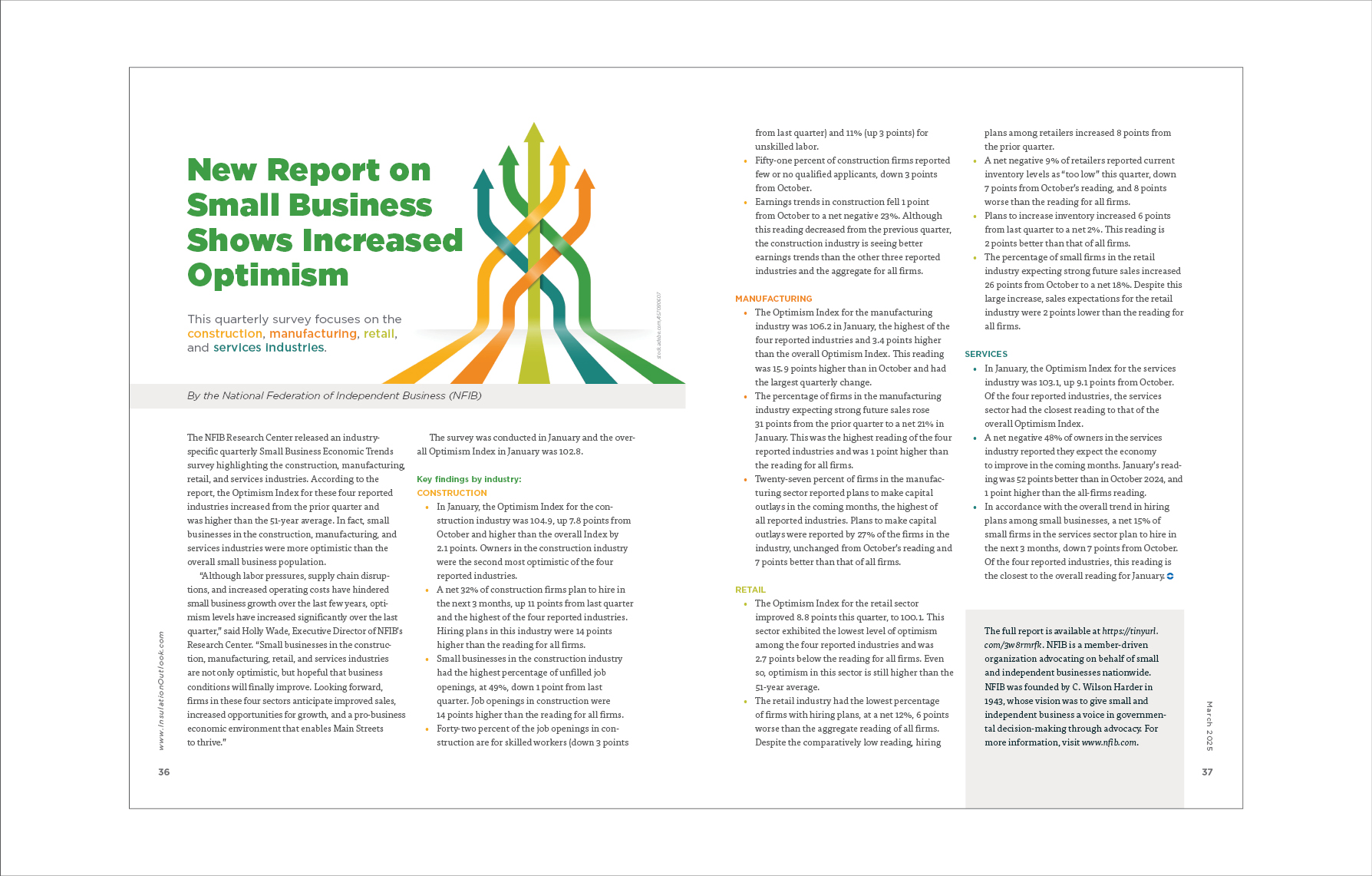New Report on Small Business Shows Increased Optimism
This quarterly survey focuses on the construction, manufacturing, retail, and services industries.
The NFIB Research Center released an industry- specific quarterly Small Business Economic Trends survey highlighting the construction, manufacturing, retail, and services industries. According to the report, the Optimism Index for these four reported industries increased from the prior quarter and was higher than the 51-year average. In fact, small businesses in the construction, manufacturing, and services industries were more optimistic than the overall small business population.
“Although labor pressures, supply chain disruptions, and increased operating costs have hindered small business growth over the last few years, optimism levels have increased significantly over the last quarter,” said Holly Wade, Executive Director of NFIB’s Research Center. “Small businesses in the construction, manufacturing, retail, and services industries are not only optimistic, but hopeful that business conditions will finally improve. Looking forward, firms in these four sectors anticipate improved sales, increased opportunities for growth, and a pro-business economic environment that enables Main Streets to thrive.”
The survey was conducted in January and the overall Optimism Index in January was 102.8.
Key findings by industry:
CONSTRUCTION
- In January, the Optimism Index for the construction industry was 104.9, up 7.8 points from October and higher than the overall Index by 2.1 points. Owners in the construction industry were the second most optimistic of the four reported industries.
- A net 32% of construction firms plan to hire in the next 3 months, up 11 points from last quarter and the highest of the four reported industries. Hiring plans in this industry were 14 points higher than the reading for all firms.
- Small businesses in the construction industry had the highest percentage of unfilled job openings, at 49%, down 1 point from last quarter. Job openings in construction were 14 points higher than the reading for all firms.
- Forty-two percent of the job openings in construction are for skilled workers (down 3 points from last quarter) and 11% (up 3 points) for unskilled labor.
- Fifty-one percent of construction firms reported few or no qualified applicants, down 3 points from October.
- Earnings trends in construction fell 1 point from October to a net negative 23%. Although this reading decreased from the previous quarter, the construction industry is seeing better earnings trends than the other three reported industries and the aggregate for all firms.
MANUFACTURING
- The Optimism Index for the manufacturing industry was 106.2 in January, the highest of the four reported industries and 3.4 points higher than the overall Optimism Index. This reading was 15.9 points higher than in October and had the largest quarterly change.
- The percentage of firms in the manufacturing industry expecting strong future sales rose 31 points from the prior quarter to a net 21% in January. This was the highest reading of the four reported industries and was 1 point higher than the reading for all firms.
- Twenty-seven percent of firms in the manufacturing sector reported plans to make capital outlays in the coming months, the highest of all reported industries. Plans to make capital outlays were reported by 27% of the firms in the industry, unchanged from October’s reading and 7 points better than that of all firms.
RETAIL
- The Optimism Index for the retail sector improved 8.8 points this quarter, to 100.1. This sector exhibited the lowest level of optimism among the four reported industries and was 2.7 points below the reading for all firms. Even so, optimism in this sector is still higher than the 51-year average.
- The retail industry had the lowest percentage of firms with hiring plans, at a net 12%, 6 points worse than the aggregate reading of all firms. Despite the comparatively low reading, hiring plans among retailers increased 8 points from the prior quarter.
- A net negative 9% of retailers reported current inventory levels as “too low” this quarter, down 7 points from October’s reading, and 8 points worse than the reading for all firms.
- Plans to increase inventory increased 6 points from last quarter to a net 2%. This reading is 2 points better than that of all firms.
- The percentage of small firms in the retail industry expecting strong future sales increased 26 points from October to a net 18%. Despite this large increase, sales expectations for the retail industry were 2 points lower than the reading for all firms.
SERVICES
- In January, the Optimism Index for the services industry was 103.1, up 9.1 points from October. Of the four reported industries, the services sector had the closest reading to that of the overall Optimism Index.
- A net negative 48% of owners in the services industry reported they expect the economy to improve in the coming months. January’s reading was 52 points better than in October 2024, and 1 point higher than the all-firms reading.
- In accordance with the overall trend in hiring plans among small businesses, a net 15% of small firms in the services sector plan to hire in the next 3 months, down 7 points from October. Of the four reported industries, this reading is the closest to the overall reading for January.
The full report is available at https://tinyurl.com/3w8rmrfk. NFIB is a member-driven
organization advocating on behalf of small and independent businesses nationwide. NFIB was founded by C. Wilson Harder in 1943, whose vision was to give small and independent business a voice in governmental decision-making through advocacy. For more information, visit www.nfib.com.

